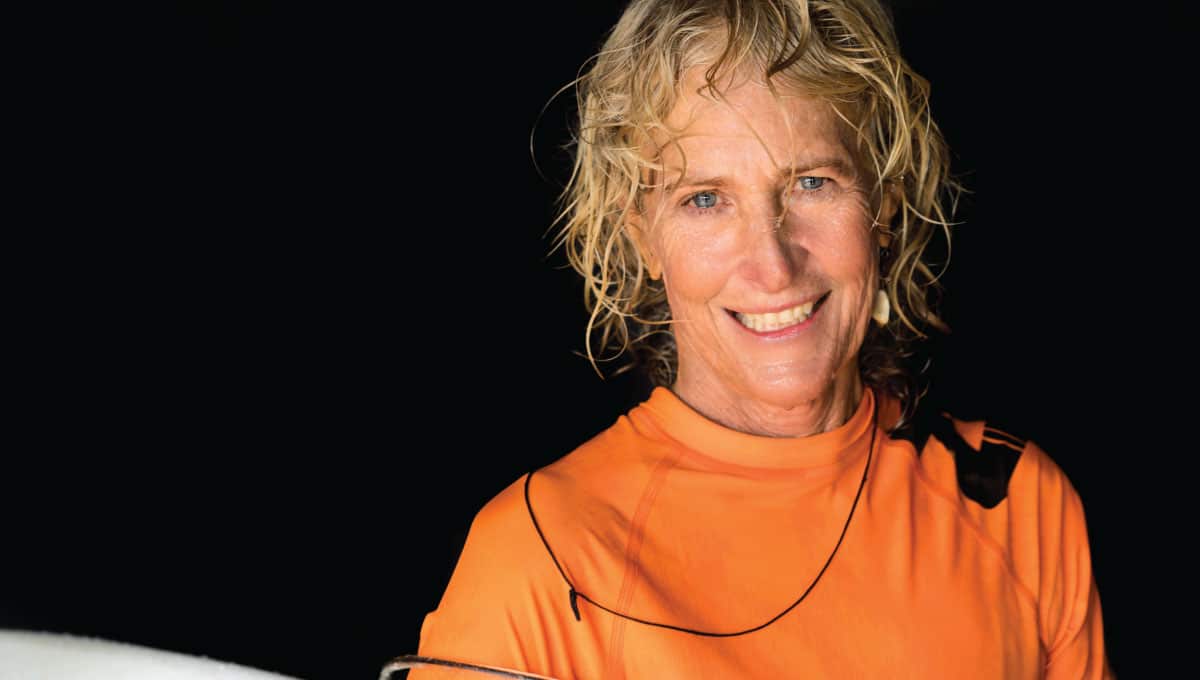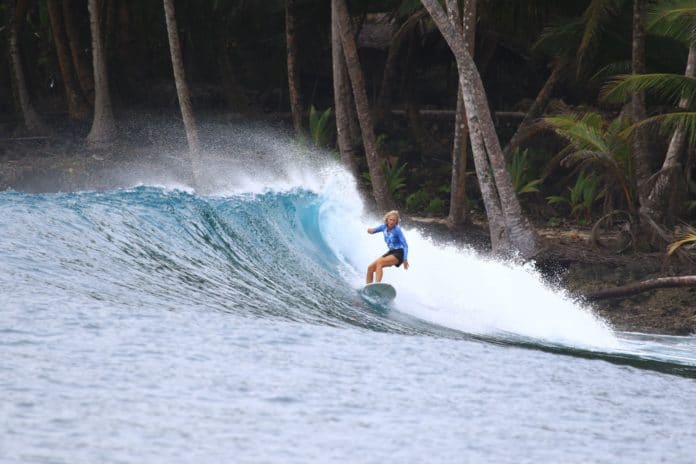Maybe you were inspired by surfer Patti Sheaff. Surfing is a magical, mesmerizing sport. The surfer paddles out into the ocean, and at just the right moment slides down the glassy wall of the wave and harnesses its energy to ride to shore.
Surfing may seem unattainable for those of us who have done nothing more than body surf, especially if you’re on the north side of 50. But if you’re in good shape and are willing to work hard, it’s never too late to learn.
Patti Sheaff, who has surfed for nearly 50 years, has a friend who successfully started surfing in her 40s. But learning to surf requires hard work and dedication. “To get good, it takes a lot of motivation,” says Patti. “It’s not like snowboarding; with snowboarding, the mountain doesn’t move. It takes a while to sit on a board without falling over. It’s challenging. It takes a lot of time in the water to get the feel of waves.”
With realistic expectations, surfing can provide physical and mental rewards. “I would learn to surf for the pure enjoyment of learning to surf,” says Patti. “Do it for the pure joy of being in nature and leaving your troubles on the sand and being cleansed.”

Here are 10 Tips for Older Beginners:
- When it Comes to Boards, Size Matters: “The longer board, the more stability. The better you get, the shorter the board. A lot of people go out on a short board and try to surf and they can’t,” says Patti. Starting on a soft top surfboard is the easiest and safest way to learn how to surf. It will be easier to paddle, easier to catch more waves, and you will have less chance of hurting yourself. Look for a 9-foot plus foam top surfboard.
- Dress Properly: A wetsuit can offer better buoyancy besides just keeping you warm. Summer in Southern California, a 2 mil will work; in the winter, go heavier, 3.5. Even in Hawaii, in the winter on a cloudy day, you will not regret having at least a rubber vest or a rubber shirt. If it’s warm, wear a rash guard, as bare skin against a surfboard can quickly become irritated and leave a painful rash. If you do get board rash, get some Belly Jelly, it helps.
- Book a Lesson: Many beaches have surf schools where you can learn the proper techniques. Learning to surf without an instructor who can teach you the ways of the ocean is like going to the top of a mountain never having skied before. Doable, but hazardous to your health. The very best place to learn to surf is Waikiki, the wave of Elvis and Gidget: soft, predictable, and makes for very long rides.
- Don’t Forget Your Sunscreen: The sun and surf can be tough on your skin. After years in the sun, she’s had a few skin cancers. She slathers on Banana Boat Baby Sunscreen Tear-Free Sting-Free Broad Spectrum Sun Care Sunscreen Lotion SPF 50. For really intense protection, the lifeguards in Hawaii use Shiseido Sun Protection Stick, super water resistant.
- Get Comfortable in the Ocean: Surfing is actually 95% paddling. Before you consider surfing, you should be a good swimmer. You also need to get used to the rhythm of the waves and the way they break. That means getting out there on a regular basis. “Time spent in the water is the only way to know. Breaks are different on low-tide and high-tide times of day, and the wind will have a powerful effect on your ability to catch waves. Every day is different.” Go to the beach, observe the ocean for a good 15-20 minutes if you have not surfed there before; use the time to stretch. The difference between a normal wave and a big set wave can be surprisingly large.
- Choose the Right Spot: “People make the mistake of paddling out to the middle of the pack at Topanga Beach [a Malibu surf spot frequented by experienced surfers],” says Patti. “Surfing is pretty territorial. We tend to protect the good spots.” If you go to an experienced locals-only spot, you are in for some hassle. According to Surfline.com, look for “waves where you can carry your board with the wax facing inward, put your leash on the wrong foot, or blindly neglect the rules of the lineup without major consequences. These spots are the bunny hills of the surf world.” Also, make sure it’s a patrolled beach, within sight of a lifeguard. You want to look for the beginners (kook) beaches, and stay way clear of the good surfers. Ask at the local surf shops — they will clue you in where to go and which breaks to avoid.
- Respect Surf Ethics: These are the unwritten guidelines that include not dropping in on another surfer’s wave, holding onto your board to prevent it from causing injury to others and surfing on waves consistent with your ability. Surfing can be dangerous, especially to your fellow surfer if you do not control a loose board. If in doubt, ask a veteran surfer to lay out the rules for you.
- Relax: Patti says novice surfers try to muscle it up. You are going to fall, everyone does, and it will be easier on you if you don’t fight while getting worked by the wave. “If you tense up, the waves will have their way with you. If you relax [think of a rag doll], you become fluid. Think of a dolphin.” Come up, get some air, grab your board and look where you need to be if there is another wave coming. Often just 10 feet out of the impact zone is all you need.
- Work on the Pop Up: The pop up is the motion of moving from a paddling position to a surfing stance. It requires upper body strength, core muscles, strong legs and balance. Surfer Today recommends practicing your pop up on your beginner board on the beach or any flat surface if you don’t have a board handy. “The faster you get up, faster you can pump down the line [of waves],” says Patti.
- Don’t Worry What Anyone Thinks: Get out there and do your thing, says Patti. It may take days, weeks and even months to stand up. You may spend all your time paddling out without ever catching a wave. She says there’s a saying in surfing: “The best surfer is the one who’s having the most fun.”




Thank you so much for this information!! I am almost 42 and have never been on a board. I am dying to get out there!! First things first: get rid of this spare tire (or at least let some of the air out) and work on my cardio. The waves at my local beaches are more like ripples that are slower moving, so I would think that would make it for an easier environment for beginners. Long boards provide a better ride on these waves. And, as I get more mature with my wave riding, I imagine I will want to hit some of the bigger breaks. Who knows, maybe with enough dedication and practice, I could one day be ready for the Banzai Pipeline!!
72years young. 113kg.6’4″.Just bought a 9.0ft TJ. Need more bouyancy. Found out how unfit I am but dedicated to get the better from those waves wanted to kick my ass. Ex ski instructor. Ex 6’4″ twin fin surfer. Went waveskiing for 30 years. Just want that feeling back, sitting out the back, relaxing, chilling. Now, commit by not giving up paddling. Got it BUT very slow popup. Next, hands closer to my feet to let momentum getting me standing with bent knees, just like skiing. Benz the knees. Got my first short ride since 30years ago. Motivated. Hi from New Zealand, free of COVID, & plenty of pre Christmas waves before the tourist come. Come and live in New Zealand. Freedom.
That’s a good story. I’m 73 and I started 11 years ago. I live in the mountains so I get to surf on trips to MX and HI. You really need time in the water and the motivation to find it. Good luck!
I’ve loved reading this. I’m 57 and my 14 yr old took up surfing a year and a half ago .I decided I’d join him and have spent that time just being able to get on my knees. I’d love to be brilliant but really I don’t care. I love to keep trying. It’s good for resilience and makes me feel full of joy I’ll let you know if I ever stand up!
66, male, still pretty fit, land-locked in Charlotte, NC. Always a water lover: swimming, snorkeling, SCUBA, body surfing (did The Wedge, poorly, at Newport Beach). Retired, financially comfortable. Dreaming of learning the water sport I SHOULD have learned when I lived in So. Cal. for 7 years.
I’m 59 and grew up at the ocean’s edge. Tried surfing with a long fiberglass board when I was 16. The third time it hit my in the head, I gave up. I’m not in good shape, but this gives me a goal. Maybe just sitting out there and paddling in will be good enough, but I really want the feeling of being one with the wave again, the way I used to do body surfing and boogie boarding, but better.
It’s never too late to surf. Surfing is one of the most rewarding sports out there. You can enjoy it anywhere in the world you may be. You can even learn it while on holiday by hitting one of these surfing resorts that has a relaxing atmosphere, and delightful cuisines:
https://3dfins.com.au/blogs/media-spotlight/the-best-luxury-surf-resorts
I’m 55, Victoria, Australia. Surfed as a youth then took a 20 year break. Now I’m obsessed with it. Choosing the right board is critical and keeping realistic expectations when you start out. It takes a while to get the hang of it. Also, lose some weight. Everything about surfing is harder if you are carrying too many extra kilos.
Very motivating. I am 47 I moved to Florida and I keep envying the surfers. Scared to death but might give it a try. My son has a board so tomorrow I’ll start land pop ups
I recently moved to Waikiki I’m 60 years old and just took my very first surf lesson, I was able to stand just for a few moments then I fell, absolutely the best I felt in years. I’ll keep you posted 😊
How about trying to learn to surf with Meniere’s! Any tips? My one experience was fun, but not highly successful!
Thank you for this! Starting at age 52, this summer at Doheny Beach in SoCal. It is exhilarating just to think of being out there, trying hard.
Hi, where are good places to start to learn after 52 at?
Hey Patti. This is Karim an old friend of yours from Santa Monica CA on ashland Avenue. How are things going. I was searching on how to lean surfing at age 50s and your post popped up. I hope all is well.
Learning to surf at 51 and a half. It’s brutal. I tried in my mid 30s but I wasn’t committed so I gave up. I bought a board back then but never practised or got up. Now it’s different. I am soooo determined to do it. I’ve given everything else away to focus wholly and solely on surfing just to make it my “one thing”. So I engaged a coach from day 1 and that was beg Sept this year, it’s now Dec. she was fantastic but I saw her just once a week for about 6 weeks without a board. I ended up buying a foamy 7’6” (her recommendation) and I go out 3-4 times a week if not more. Every time it’s brutal. I’m knocked around and end up ass over tit. I have got up for say 2 – 5 secs maybe 10 times in 6 weeks I’ve had my board. Today, I was so despondent after watching the waves for a good 15 mins before getting in and seeing a guy out there manoeuvring like a pro, I thought it looks simple. Well that was a mistake.
A heads up, I took 3 months before I called the coach to get into a routine to lose weight and get fit. I did yoga 35 mins intense 7 days/week (which incl a lot of balance) plus jogging for an hour with stairs. I was always fit until my mid 40’s hence why I needed to course correct and have done so. I am a great swimmer and was in lifesaving here in AU so I have the knowledge of surf and able to paddle.
I now do my yoga session before every surf and that has been a godsend because it has helped with strength and recovery from the endless stacks. I also am religious with my pop up repetition training every day. So with this in mind and getting to a point of feeling like I’m not cut out for this (despite pure determination) as I seem to have very little wins, what would be your advice?
PS I realise my board is smaller than a 9 ft but it fits in my car and I am loving it and used to it now.
I do love the joy of being out in the ocean and I agree with the tip above about just getting out there and paddling. Because essentially that’s what I have been doing for 6 weeks straight. Even when it looks crap I still go out and invariably a wave set comes that is good for me. It’s just the getting on the wave and getting up that seem to elude me. And the tip about caring what others think is also true. I have had so many stacks and crashes and there are people watching on. I simply could not care less. This is my journey. So that’s a great tip for beginners. I do love to watch good surfers but I do fall into the trap of comparing myself which is to be avoided at all costs.
By the way, I’m surfing on the Mid North Coast of NSW Australia, specifically Diamond Beach down to Seal Rocks. A bonus is seeing the dolphins and getting the pleasure of them surfing and jumping out of the water a mere moment away. I’ll never tire of that.
Thanks for taking the time to read.
Hi
Just back from Bali, where I decided to try surfing again. I am 50. I tried 30 years ago, got a couple of lessons but never really committed.
So….at Bali I managed to stand up about 20 times over 2 x 1 hour sessions. Very pleased. By the way, Bali Nusa Dua has a very friendly smaller break, its where Melia hotel is. Lots of international beginner to intermediate surfers. The bug stuff is at Kuya, Ulawatu, Conggu..stay away from there!
My tips, not that I am an expert
I used a 9ft mini-mal soft board, it was very buoyant and great in small to medium waves
Learn how to paddle…but also get good at resting when you are out there…be selective with waves.
Quit when your are tired, my mark was about 1 hour.
Find the centre of the board, yiur chest should be about there when you paddle, and your front foot should be there when you stand. More or less
Front in centre width wise as well, very important. Front foot takes about 89 to 90 per cent of your weight. It’s very Front foot for you snow boarders
Like when you go snowboarding as a beginner/intermediate or as you get older , you don’t do black runs, so choose small waves and don’t be embarrassed to surf the mush after the wave breaks..I think it’s valuable time to work on your balance (forgot to say stick your arms out as you try to balance)